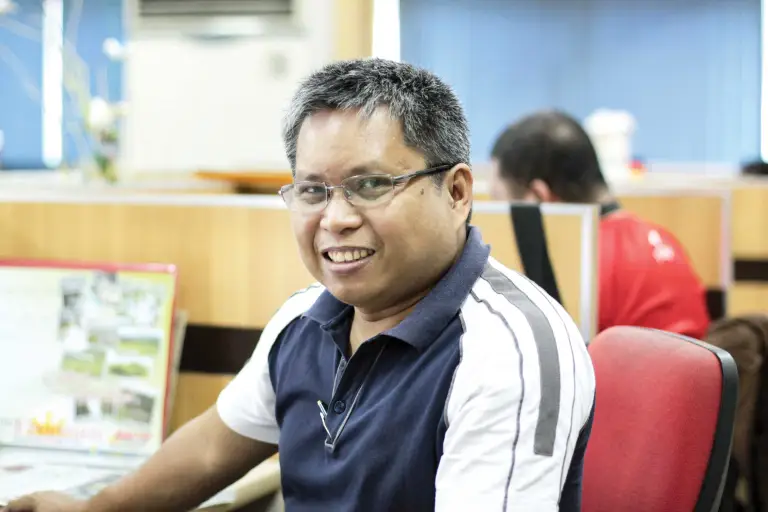New bosses in the newsroom
More persons of interest

New bosses in the newsroom
GINGGING A. CAMPAÑA
Oct. 19, 2017
No day off, reporting in three languages—these new leaders of the newsroom meet challenges head on while keeping the troops happy and in line. Still “one of the boys,” but they now make the rules.
The Freeman editor-in-chief Archie M. Modequillo considers the readers’ shift toward social media as the paper’s biggest challenge. He wants a change in the paper’s culture to rise to the new challenge, and is confident this can be achieved with everyone’s cooperation in “improving content and adapting new technologies—even if slowly but consistently.”
A graduate of B.S. Psychology from the University of San Carlos, Cebu City, Modequillo also took up a course in movie arts and science in Caxton Foundation School in the US.
Inspired by the Hollywood producers who “never blink amid formidable challenges and the great Oriental sages that see the connectedness of all things,” this filmmaker and TV producer was responsible for the success of major international TV programs for 17 years. In the 1980s, Modequillo helped made Smash FM Cebu number one while he was program manager for almost seven years.
Modequillo, who looks up to Christiane Amanpour and Lee Iacocca, adopts the casual, just-one-of-the-boys management style, but vows to strictly enforce the rules and “make rules where there are none.”
On his first week as EIC, he received this e-mail from a reader: “I really knew you could do the job. I’ve been following your writing since years back, and I think I know you enough to believe you are fit for the position. Congratulations, Ma’am!”
Jhunnex Gabica Napallacan

Mentored by the late longtime KBP chairman Cerge Remonde, Jhunnex Napallacan spent most of his career in dyLA from 1996, as a reporter, desk man, anchor man, newscaster and later as news director before he became station manager last year.
Improving dyLA’s finances is Napallacan’s biggest challenge because he has to ensure that they can sustain the operation and pay the personnel on time. Napallacan had to cut costs and launch new programs to gain more listeners, a factor in attracting advertisers.
Another test is the lack of personnel, so he does most of the work as early as 4 a.m., including writing the editorials and delivering the regular newscasts. He has no day off. But Napallacan is hoping to solve everything with the help of the sales department.
His love for radio drama and high regard for three veteran broadcasters drove Napallacan, an information and computer science graduate, to work in broadcast. He recalls listening back then to Leo Lastimosa and Edgar Gutierrez, whom he later worked with in dyRF after graduation.
He leads by example and is not bossy, but he calls the staff’s attention if they become complacent.
He also has to deal with complaints. Napallacan says he now understands how his predecessors Marit Stinus-Cabugon and Jun Tagalog felt then when he complained. Tagalog told him recently, “Unya, kasuway na ka?” (So, do you now know what it’s like?)
Angelie Brito Tajapal

Bombo Radyo-Cebu OIC news director Angelie Brito Tajapal, who finished her broadcasting degree at the West Visayas State University in Iloilo City, never saw herself becoming a manager, especially handling people years older than she.
She hates confrontations. If she gets mad or scolds them, she is the first to cry, she said in jest. Tajapal makes it clear to colleagues that they can talk to her, not through others or through Facebook. Before her transfer to Cebu, Tajapal was a Capitol beat reporter and chief of reporters for three years in Bombo Radyo-Bacolod. She notes that most of today’s new reporters do not know how to speak and write in Cebuano.
“Nawala na tong mga lawm nga Bisaya nga nindot kaayo paminawon og dali masabtan sa tanan,” Tajapal said, adding that reading more Cebuano articles and the Bisaya Dictionary would help.
For Tajapal, the accuracy of the content is important, especially since there is a lot of fake or sensationalized news nowadays. She follows the network’s mantra: “Get it first, fast and right.”
At the height of the Abu Sayyaf terror group’s encounter with the government troops in Bohol last May, Tajapal was alone in the newsroom and had to give updates to their sister stations in three languages: Bisaya, Hiligaynon and Tagalog. There came a time that she mixed up the languages in her report, to the amusement of one of the anchors.
Lucky Pagalan Malicay

Lucky P. Malicay is editor-in-chief of Banat News and managing editor of The Freeman. He started in the newspaper industry as reporter in Mindanao in the 1990s. Before becoming a journalist, Lucky wanted to be a Seventh-day Adventist pastor. But his passion for writing and current events led him to embark on a career in journalism. A native of Tambulig, Zamboanga del Sur, he considers Cebu as his second home. Lucky is married to a Cebuana, with whom he has two daughters.
He had always wanted to become a Seventh-day Adventist pastor, but Lucky P. Malicay’s passion for current events led him to a career in journalism. He looked up to his father, a voracious reader, a historian and a smart company manager.
Malicay rose from the ranks to become the managing editor of The Freeman and editor-in-chief of Banat News. He was news editor for seven years and copy editor for three years.
Before joining The Freeman (Cebu), he was news editor of The Freeman Mindanao, which used to circulate across Western and Northern Mindanao, from 1998 to 2004. But long before that, he was a reporter for several weekly papers in Mindanao in the early 1990s and became a stringer for Agence France Presse. He also writes for some online publications, and some of his articles were published in the Australia-based The Roar and Digital Journal in Canada.
The rise of social media is his biggest challenge. “We have to compete by strengthening The Freeman’s online and social media operations.”
Malicay never rules with an iron fist, as long as everything in his department runs according to plan. “I’m just your ordinary newsroom boss,” he said. 

New media landscape modifies competition among newspapers
Interview with Lucky P. Malicay by Pachico A. Seares
You are an “import” of sorts as you started learning your journalism skills in Mindanao, not in Cebu, although you have worked here for a decade or so. How did you overcome the initial “handicap” of not being a native Cebuano in your job of providing news and information to the Cebu audience?
The moment I arrived in Cebu, I immediately started to update myself with local current events. The initial “handicap” was not really a big deal because I had been in a similar situation when I was a reporter covering Mindanao, specifically Zamboanga del Sur, Misamis Occidental and Lanao del Norte.
Reporters in Metro Cebu, being a highly urbanized area like Metro Manila, were lucky enough to have easy access to news sources through the help of technology. During my time in Mindanao in the 1990s, it had been part of the job to travel for hours to get the story.
As editor-in-chief of Banat News, a Cebuano-Bisaya daily, and managing editor of The Freeman, an English daily, you shuttle from one desk to another, in two languages and with different formats. Banat is tabloid in content and size while Freeman is tabloid-sized but with the content of a broadsheet. How have you managed it?
Time management.
My association with Banat News started in 1998 when I began writing my “Saksak Sinagol” column. From that year, I also served as its contributing editor until the early 2000s.
I had already learned every process of its operation even before I was appointed the managing editor in 2014. So when I became its chief editor in February this year, I did not really have a hard time adjusting to my new role.
At The Freeman, I rose from the ranks since 2004. So it was not also hard to adjust when I became its managing editor in 2014.
Good thing The Freeman and Banat News share the same newsroom, which allows me to fulfill my daily responsibilities.
The challenge that most, if not all, print publications face is how to survive the change in consumer demand: readers want their news and information whenever and wherever they need it. Newspapers are hobbled by the problem of a 24-hour news cycle as against the day-round availability of the product in other platforms. How has this affected your work as newsroom leader?
For newspapers to stay relevant in these times, they must introduce new ideas to be more competitive. Since every newspaper has its own style, it really depends on what direction a particular outlet should pursue. Unlike before, there is now a lot of pressure engulfing the newspaper industry with the arrival of new platforms. As a newsroom leader, the pressure only drives me to explore new relevant approaches.
How should community newspapers cope with the need for a different and better news and information package than what news outlets online offer?
Aside from the need to present concrete news, community newspapers should also learn to publish stories that offer a more compelling angle. Newspapers always have the advantage over online news outlets when it comes to offering solid stories.
Unfortunately, the drive to present a story with complete details is no longer enough. Newspapers must innovate, not just physically but digitally, in order to survive.
Besides, the battle for survival has now taken a different direction, away from the traditional competition among newspapers. Today’s real fight to stay relevant is being fought between the entire industry and the digital platforms.
What are demands on the present working journalists, particularly your reporters, that were not there five or 10 years ago?
Today’s reporters, especially those beginners, should equip themselves with additional weapons. Many of the skills they learned from school are no longer applicable in the real battle. They have to develop their own competence.
Yes, they still need the basic techniques. But the presence of online news outlets and social media has so changed the landscape that journalists now need to present the bigger picture of the story, including its effects on public lives.
If a mass-com college asks you what its graduates should learn to be considered for employment in your newsroom, what would you specify as the more important skills and values they must have?
The ability to present a news story that satisfies the reader has always been a basic requirement, and for journalism graduates to get the job, they must develop a “nose for news.” However, knowing how to write a good article is something that can be learned in the long run.
But it’s sad that only few mass-com graduates are interested to work in the media industry nowadays. Most of them prefer to try their luck in business process outsourcing, the PR world and in big corporations that offer more monetary benefits.
I have noticed that many of those who apply for reporter today want the job just for the experience and the thrill of being in the media industry.
How can a local newspaper stay relevant to its community in these times? Tell us where print media can do a better job than its digital counterparts.
Because of mounting pressure owing to stiff competition, it’s no longer enough for a newspaper to just present a story with all its details. While telling a story as it happens has always been the practice of newspapers in their mission to inform the public, the demand to look beyond the script has become more important. Going beyond the story for the readers to further understand gives newspapers the advantage over their digital counterparts.
Yes, physical innovation is one thing that should help newspapers stay afloat. Therefore, to entice more readers, especially the younger ones, a community newspaper needs to broaden its physical appeal. 
